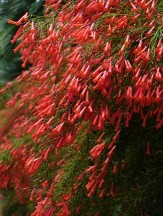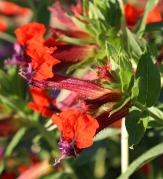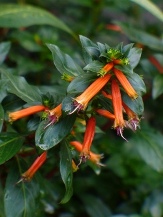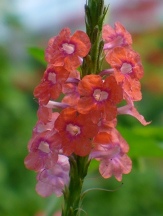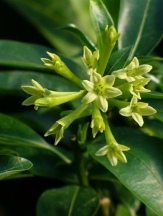.JPG)
Grand Duke of Tuscany Sambac Jasmine
How to Grow, Prune, Fertilize, and Plant Sambac Jasmine and its Cultivars
This guide includes instructions for growing Grand Duke of Tuscany, Elongata, Grand Duke Supreme, Belle of India, as well as the common forms Sambac Jasmine
Note: all images in this guide are clickable if you need a larger image or would like to learn more about the plants pictured here
Sambac Jasmine, Arabian Jasmine, or Pikake (Jasminum sambac) is a tropical evergreen which produces a continuous show of fragrant flowers throughout the warmer months on well-established plants. These Jasmines are somewhat scandent or vine-like shrubs that can produce long canes from time to time that allows for the plant to be espaliered on a trellis or other vertical support if so desired. If you prefer to keep it in a shrub form simply prune it to the desired form and head back any extra long canes.
Sambac Jasmine will need a good quality well-draining somewhat acidic potting soil. The variety ‘Grand Duke of Tuscany’ is slower growing than most other types of Sambac Jasmine which makes it a good choice for container culture (all Sambac Jasmines can be enjoyed as container plants) and it has the advantage that it’s wonderfully fragrant double gardenia-like flowers last a good deal longer than the single ones. If and when you do uppot your Jasmine go up by no more than one container size at a time. If it’s in a 6” pot uppot it to an 8 or 10” pot but no larger, if it’s in a 4” pot step up to a 6” or 1 gallon sized pot. The reasoning behind this is that if you have too much soil that is not utilized by the plant's root system it may stay too wet for too long of a period and can set the plant up for disease problems. Too wet and planting too deep are the main causes of plant death in Sambac Jasmines.
.JPG)
Elongata Sambac Jasmine
Sambac Jasmines will grow under full sun conditions, although we find that in our hot zone 8B summers that afternoon shade will help to maintain a darker green foliage while still providing ample flowers. If grown in full sun where summers are particularly their foliage may yellow somewhat during the heat of summer. These are tropical plants and so they do relish a certain amount of humidity, with that in mind we prefer to grow them outdoors at least during the warmer freeze and frost free months of the year and typically they will reward you for it with vigorous growth and a summer long supply of their wonderfully fragrant flowers. They should be protected from freezing temperatures, although they are reported to be root hardy in zone 9 they will flower more and become larger plants if protected from such conditions. When grown indoors provide your Jasmines with as much direct sunlight as possible, they will tolerate high light conditions but will flower more and produce more vigorous and healthier plants with direct sunlight.
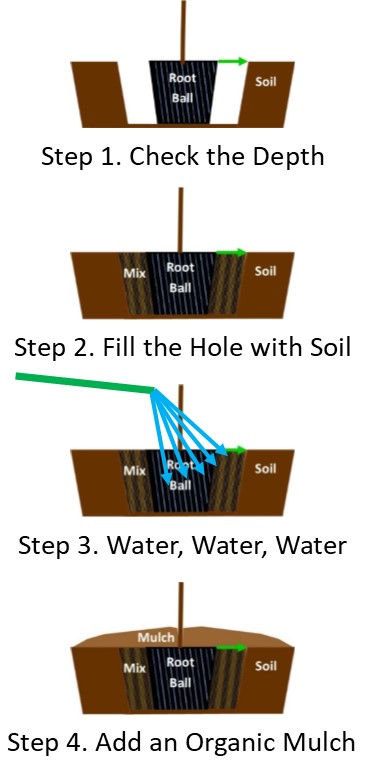
Planting Steps for Soils with Average or Better Drainage
This Jasmine has average water requirements but will sulk if kept too wet and can succumb to root rot if kept overly wet. The easiest way to determine if it's time to water them is by sticking your finger in the soil to the depth of your first knuckle, if the soil feels dry and room temperature it is probably time to water, if the soil feels moist and cool, then it's not yet time to water. When watering, water from the top and let the water drain into the saucer (if you absolutely need a saucer, outdoors we prefer not to use saucers), after 30-40 minutes dump out any excess water left standing in the saucer. If all of the water was soaked up from the saucer, the plant may require a second watering. Leaving your plants sitting in a saucer of water will often lead to suffocation of the root system for lack of air and will promote fungal and disease problems and in the case of Sambac Jasmine root rot. Over time, you will become more familiar with how much and how often to water your plants. If at any time, the soil becomes so dry as to shrink away from the sides of the pot, you may need to water it thoroughly several times or soak the entire pot, in a container of water until the soil has become fully re-saturated, this could take up to 1-2 hours to complete under extreme circumstances.
Sambac Jasmines do need a soil rich in nutrients to grow and flower. As they flower on new growth it is important that they have the resources available to maintain plant health and vigor. A combination of periodic liquid fertilizing and a good quality balanced slow release fertilizer ( like Scotts Osmocote® 14-14-14 which is what we use ) will help to achieve that. A good rule of thumb is to apply about one tablespoon of a fertilize similar to Osmocote 14-14-14 to the soil’s surface about once every 3 months at the start of and during the growing season. You generally want to stop fertilizing about 6-8 weeks before the first average frost date for plants that are grown in the ground as this can push late tender new growth that can get frost or freeze damaged.
.JPG)
Grand Duke Supreme Sambac Jasmine
Pests and diseases are not usually much of a problem with this plant but it is important to be aware of the ones that most commonly affect them. Sambac Jasmine is susceptible to a variety of sap sucking insects and heavy infestations can cause the plant to go into decline. White Flies, Scales, Spidermites, and Mealybugs are all common pests on these plants and can usually be easily controlled through mechanical or chemical means. If the surface of your foliage is turning black like it has a soot-like mold on it, this is usually a good indication that one of these pests may have made a home on your plant. Horticultural oil is a good choice but will have to be applied, following all directions on the product label, up to 4 times at about 1-week intervals to fully eradicate the pests. Another important thing to note is that most of these insects live underneath the leaves and so this is where we start looking for infestations and where the spray must be applied in order to be effective. Always read and follow the label and use it as directed on the label. It's the law, it's your family that could be affected, or yourself or your plants.
If you are new to growing plants or would like more in-depth planting instructions please see our detailed "Planting a New Plant... Growing Guide" (just click here)
Excellent Online Resources on Growing Sambac Jasmines
Pikake - A Fragrant Flowered Plant for Landscapes and Lei Production – University of Hawaii Cooperative Extension Service
https://www.ctahr.hawaii.edu/oc/freepubs/pdf/OF-29.pdf
Jasminum sambac – Arabian Jasmine – Arizona State University
http://www.public.asu.edu/~camartin/plants/Plant%20html%20files/jasminumsambac.html
Alluring Jasmines by Rand B. Lee on page 24 of the American Horticulture Society’s January/February 2012
https://www.ahsgardening.org/uploads/pdfs/2012-01r.pdf
We hope this helps to get your Sambac Jasmines growing and flowering to their full potential! Please feel free to contact us if you have any additional questions, comments, or input.
Thank You & Good Growing,
Jeff McMillian
& the Crew at Almost Eden
![]()

